Your miniSpinner has just the right amount of power for normal spinning. If you work it too hard, the overload protection circuit will briefly turn it off to protect the motor and to tell you something is wrong.
The usual causes, in order:
- Excessive brake tension: This is, by far, the most common cause. You only need enough brake tension to draw in the spun fiber, no more. It's common for new miniSpinner owners to run more brake tension than required because you can't feel how hard it's working, unlike a treadle wheel. It also happens more often when plying, because people just want to be done with it!
The brake spring will be stretched little, or not at all, when things are properly adjusted, like this: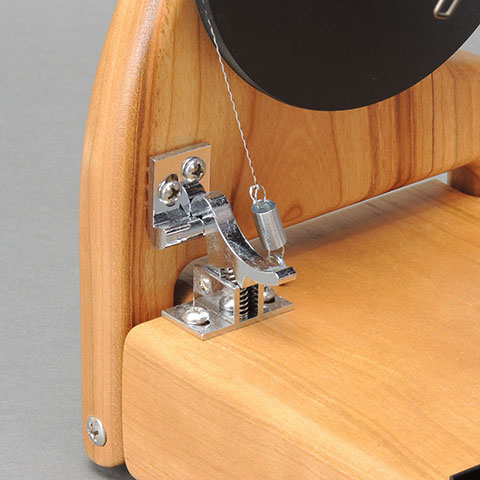
If the spring is stretched this much, you are using far too much brake tension: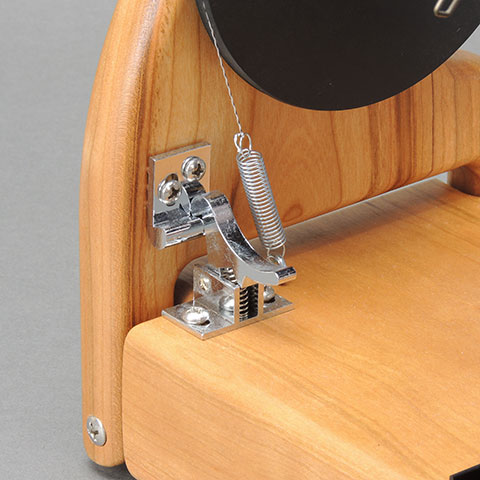
- WooLee Winder needs cleaning: If you are using a lot of brake tension and you have a WooLee Winder, it probably needs to be cleaned and oiled. This is a problem because when the WW is not working properly you will need to keep increasing the brake tension to overcome the friction of the WW mechanism. Eventually you will be running so much brake tension that the miniSpinner's overload protection will cause it to shut down to protect the motor.
If you also notice erratic takeup, this is almost certainly the problem. Assembling the WW incorrectly after cleaning will also cause problems, so read the cleaning instructions carefully!
Gee, I wonder why my WooLee Winder isn't working very well? We see this all the time...
- Brake band is loose but still has too much brake effect: If you have a WooLee Winder, check the bobbin's brake groove for rough spots; if found, sand the bobbin brake groove with fine sandpaper.
If you have a HansenCrafts flyer, the brake action may be too aggressive. Find a soft lead pencil and draw a line around the bottom of the bobbin's brake groove as shown here. The graphite in the pencil lead lubricates and smooths the brake action.
- Lack of bobbin endplay: The bobbin should have around 1/16" (1.5mm) of endplay, or a little more. If it has no endplay it creates friction between the flyer and the end bearing and causes noise and increased drag. This requires more brake tension to overcome the extra drag and will eventually cause the overload protection to shut down your miniSpinner. This is usually only a problem if you've adjusted the latch and it's too tight. Also see the next item.
Bobbin with correct endplay. You can see 1-2mm of space between the end of the bobbin and the white plastic bearing: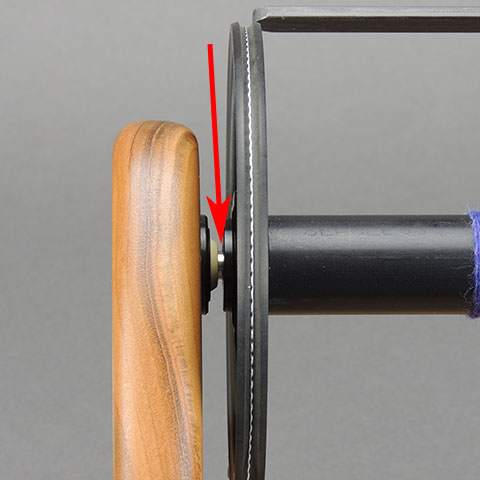
Bobbin with no endplay. You need to check if the flyer has walked out (next item). If not, adjust the latch.
- Flyer is "walking out" of the ball bearing: This can cause #4 to happen. It usually occurs when plying. You'll see a gap between the ball bearing (at the orifice end of your flyer) and the shoulder on the flyer. If this happens, remove the flyer, smear a little Super Lube grease around the outside of the orifice tube where it goes into the ball bearing, and reinstall the flyer. This prevents the flyer from gaining enough traction to walk out, and resolves the problem.
Flyer in place, magnet is tight against the ball bearing:
Flyer has walked out; note the gap between the ball bearing and the chrome ring magnet on the flyer:
- Spring on the brake band is hung up: Be sure on the latch side it's not tangled up with the latch. On the right side, there's a spring inside the body of the miniSpinner. You can check that the spring is working by grabbing the swivel on the brake band and pulling the brake cord away from the base. You should feel the spring pull it back in. (It's VERY unusual to have a problem with the internal spring.)
Note the brake band is caught under the latch. That won't do: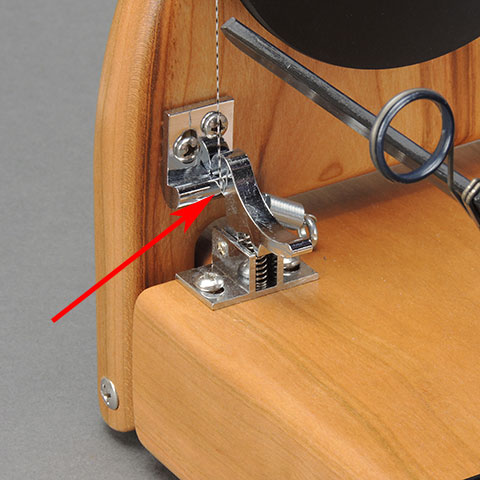
- Brake spring was replaced: NEVER substitute a spring from your spinning wheel for the original spring on your miniSpinner! It'll have the wrong characteristics and can cause your miniSpinner to work too hard and then stop unexpectedly. If you have replaced the spring, it must be the original part. A spring that seems the same will not function the same as the original part. In particular, if the spring is too strong (even a little bit), you will have a difficult time adjusting the braking and your miniSpinner will probably stop often due to improper brake function.
- Fuzz wrapped around the shaft of the motor: Check between the sheave (pulley) and the front of the motor. If there is a lot of fuzz wrapped around the motor shaft, it creates lots of drag. If allowed to accumulate to excess, the fuzz can find its way into the motor's ball bearing and ruin the motor! It is very important to keep fiber from accumulating here. Fortunately, it rarely happens anymore because we changed the design a little to leave more space here, which makes it easier to inspect and less prone to collecting fiber.
This is a good way to ruin the motor: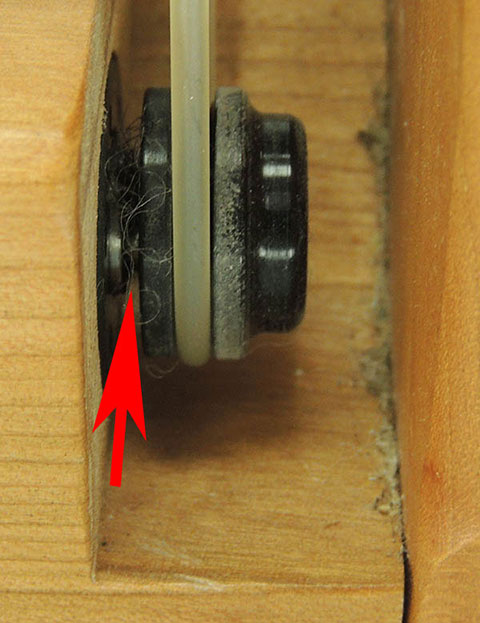
- Speed controller problem: Last, but not least, there was a short period near the end of 2012 when a few miniSpinners were shipped with a defective part on the speed controller board. The usual symptom is that the miniSpinner will start (with no load) and almost immediately stop, often before the flyer makes a complete revolution. If this happens we will replace the speed controller under warranty.
